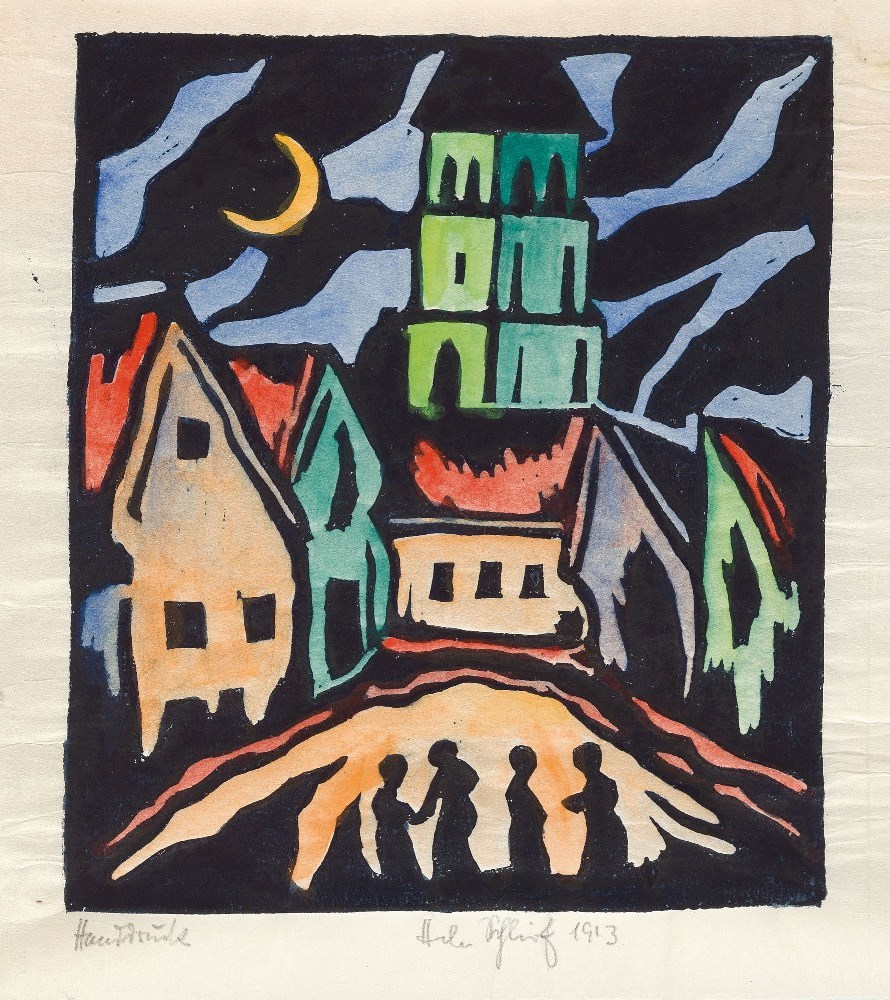Linocut on japan paper by Heinrich Schlief Titled: View of a village, 1913
Original fine art print by Heinrich Schlief. Titled: Dorfansicht (view of a village) dated 1913.
Hand colored linocut on japan paper signed and dated bottom center and called “hand print” in German at the bottom left.
It is probably one of a total edition of 10 to 15 copies.
Dimensions Sizes: image 22.5 x 19.5 cm and the paper sheet: 27 x 23 cm.
!!! Note: The artist has the original plate revised again after 1948, as the leaves from the period around 1913 were lost.
Price: *CAD (Canadian dollars)
For more information on the artist contact the gallery.
See more relief fine art prints >>
Heinrich SCHLIEF (1894 – 1971)
Heinrich Schlief was born on January 7, 1894 in Soest; and died on July 13, 1971 in the same city. He was an artist of the Westphalian Expressionistic movement.
Schlief was born in 1894 in the Westphalian Hanseatic City Soest. His father is Mathias Schlief owner of a transport company and his cousin is the locally renowned blacksmith Bernhard Schlief. As a child, he originally wanted to become a teacher, but he was steered by his elementary school teacher in to the technical field, so he worked in Soest at the (Hochbauamt) buildings department and at the Office for Cultural Affairs of that same city.
In the subsequent years, interest has developed in him for painting. When he saw the artworks of Christian Rohlfs in 1907 and in 1909 he met in Soest the expressionist Wilhelm Morgner, he decided finally to become a painter.
During the First World War, he was employed as a painter, drawer and press illustrator for the Division 236 newspaper on the Western Front.
A first audience he found in 1924 for the birthday of the city Soest celebrating their 1300 years since foundation, when he was allowed to host a special exhibition with 100 pictures.
During the Third Reich period, two of his paintings were classified as degenerate. Only after the Second World War he was able to pursue painting again publicly and has been given the management of the West German Artist Union.
Schlief liked to use various substrates as background on his artworks such as paper, glaze paper, hardboard or cardboard and he combined this with different mediums such as chalk, watercolors and oil paint to achieve special optical effects.
Typical of his work is a clear and high-contrast color scheme.
He painted mainly landscapes witch had subjects inspired by the Soester Plain and the Sauerland. Furthermore, he also created paintings during his trip through Asia and influenced by the Asian culture. Some artwork Schlief signed with his zodiac sign, Capricorn.
Around the work of Schlief is some controversy about its dating. The Soester Hans Jürgen Hoeck claims that the dates of creation on many artworks by Schlief are much later than they mention during most of his exhibitions.
#biography
Sources: #ysebaertlouisseize Wiki (German
Date:
November 2, 2019
See more artworks and bio of
AA-Graphic arts relief printing